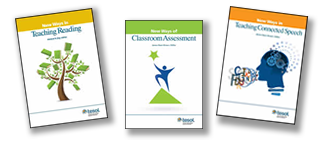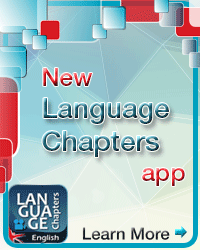TC Quick Tip: Using Movie Trailers to Teach Adjectives
by Tamara Warhol
 Audience: All levels Audience: All levels
Textbooks often present adjectives as vocabulary with relatively simple grammar rules. Students learn that adjectives are used to modify nouns and about adjective placement. Movie trailers found on YouTube or iTunes Movie Trailers provide free authentic material with which instructors can create tasks to teach adjectives. Below are suggestions of tasks that use movie trailers to teach adjectives at the novice, intermediate, and advanced levels. Instructors should choose a movie trailer appropriate for their audience.
Novice
Instructors may create a dictogloss activity using a movie trailer to teach novice language learners new adjectives and about adjective positions. Novice learners have limited vocabulary and grammar; their language production is usually limited to basic information about survival topics and formulaic expressions. A structured activity, such as a dictogloss, scaffolds novices so that they can learn, notice, and produce new vocabulary grammatically. In a dictogloss activity using movie trailers, instructors first teach new vocabulary and a “Focus on Form” lesson about attributive and predicate adjectives. The novices then watch a movie trailer in which the characters use the new adjectives in different positions. After showing the movie trailer once, the instructor distributes a cloze exercise (created using online tools such edHelper). The novices watch the movie trailer a second time and complete the cloze after having watched the trailer. Completing the cloze requires novices to notice and produce new adjectives in their correct grammatical positions.
Intermediate
Intermediate language learners may learn about different types of adjectives (such as comparative and superlative adjectives and participles) as well as new grammar (such as adjective gradability and order) by creating a marketing campaign for a movie based on information found in the movie trailer. Intermediate learners are able to successfully produce novel language structures by combining and recombining previously learned material with new input. Movie trailers provide this new input. Instructors play a movie trailer for students to watch, instructing the students to note new vocabulary items, particularly adjectives. The instructor asks students co-construct definitions for new vocabulary based on the context. The instructor then teaches a brief “Focus on Form” lesson about the target grammar point. In groups, students first write a brief press release using the new vocabulary and grammar. They then create an online movie poster using a website like Posterini. Engaging with different media and modes, students draw upon a variety of different learning styles to produce novel adjective structures in context.
Advanced
Unlike novice and intermediate learners who do not have the same facility with the language, advanced learners may critically engage the text and content presented in a movie trailer by writing a movie review. Although errors may occur, advanced learners generally are able to provide a structured argument to support their opinions. In this task, instructors show learners a movie trailer one or more times and ask them to take notes. The instructor then tells the students to use their notes to write a review of the movie and emphasizes the need for rich description. The latter instruction is given to prompt adjective usage. In pairs, students then read each others’ reviews and provide constructive criticism about organization and grammar. The lesson concludes with a large group discussion about the students’ opinions about the movie.
Movie trailers may be used across proficiency levels to teach the grammar of adjectives. Although different tasks based on movie trailers have been suggested at each level, each task may also be adapted to make them easier or more difficult.
___________________
Tamara Warhol is an associate professor of TESL & linguistics and the director of the Intensive English Program at the University of Mississippi..
TESOL Blogs Interested in writing a blog for TESOL?
Contact Tomiko Breland with your idea or for details.
Check out the latest TESOL Blogs:
|
Teaching and Learning Online: Part Two: Putting the Pedagogy First, by Andy Curtis
 After posting the first blog in this series on August 14, I received an e-mail asking about the name of this blog: Teaching and Learning Online (TLO). As we are all language teachers, in one way or another, the reader asked why the name was not, for example, Online Learning and Teaching. That was a very good question, so I thought it would be useful to explain my belief that “online” should “come at the end.” After posting the first blog in this series on August 14, I received an e-mail asking about the name of this blog: Teaching and Learning Online (TLO). As we are all language teachers, in one way or another, the reader asked why the name was not, for example, Online Learning and Teaching. That was a very good question, so I thought it would be useful to explain my belief that “online” should “come at the end.”
As a TESOL professional of color, I first heard the phrase “people of color” shortly after Martin Luther King Jr referred to “citizens of color” in 1963. And although the phrase can still spark a lively debate even today, the phrase “forefronted” being people and citizens first, and being “colored” second. Read More. |
|
The Rhetorical Situation: An Interactive Classroom Activity, by Elena Shvidko
 The concept of rhetorical situation is not easy to grasp for even the most advanced ESL writers. Even when they seem to understand it conceptually, they still may have a hard time applying it to their own writing. The interactive classroom activity that I include in today’s entry provides examples and application of purpose, audience, genre, stance, and media, and it can also serve as a great review of material that you addressed in class about the topic. Read More. The concept of rhetorical situation is not easy to grasp for even the most advanced ESL writers. Even when they seem to understand it conceptually, they still may have a hard time applying it to their own writing. The interactive classroom activity that I include in today’s entry provides examples and application of purpose, audience, genre, stance, and media, and it can also serve as a great review of material that you addressed in class about the topic. Read More.
|
|
Organization Tools for Every Teacher, by Tara Arntsen
 While I was teaching internationally, none of my schools ever had their own software to help teachers with their record keeping (for things like grades and attendance), but there are a number of free sites that help teachers do just that. From what I’ve found, it seems like Engrade, Edmodo, and Schoology are three of the best/most popular. Read More. While I was teaching internationally, none of my schools ever had their own software to help teachers with their record keeping (for things like grades and attendance), but there are a number of free sites that help teachers do just that. From what I’ve found, it seems like Engrade, Edmodo, and Schoology are three of the best/most popular. Read More.
|
|
TESOL Symposium and Annual CAMELTA Congress: An Overview, by Christine Coombe
 As part of my summer vacation, I had the great pleasure of serving as a plenary speaker at the TESOL Symposium on K–12 Teacher Development and Training on August 12, 2012 and the 12th Annual CAMELTA Congress on August 13–14, 2013. This 1-day event planned jointly with TESOL International Association and CAMELTA (Cameroon English Language and Literature Teachers Association) and held at the Catholic University of Central Africa, Ekounou Campus in Yaounde, Cameroon, provided a unique opportunity for teachers, teacher trainers and administrators in Cameroon, Africa, and EFL contexts worldwide to explore effective policies and practices in K–12 teacher development. Read More. As part of my summer vacation, I had the great pleasure of serving as a plenary speaker at the TESOL Symposium on K–12 Teacher Development and Training on August 12, 2012 and the 12th Annual CAMELTA Congress on August 13–14, 2013. This 1-day event planned jointly with TESOL International Association and CAMELTA (Cameroon English Language and Literature Teachers Association) and held at the Catholic University of Central Africa, Ekounou Campus in Yaounde, Cameroon, provided a unique opportunity for teachers, teacher trainers and administrators in Cameroon, Africa, and EFL contexts worldwide to explore effective policies and practices in K–12 teacher development. Read More.
|
TESOL Bookstore

Looking for classroom ideas for Monday morning?

These popular books in the New Ways series are now updated and revised, featuring
-
New activities inspired by state-of-the art developments in teaching English learners
-
Expanded resources needed for today’s classroom
-
More of what made the first editions become best sellers: classroom-ready activities contributed by ESL and EFL reading teachers for ESL and EFL reading teachers
New Ways in Teaching Reading, revised
Richard R. Day, Editor
New Ways of Classroom Assessment, revised
James Dean Brown, Editor
New Ways of Teaching Connected Speech
James Dean Brown, Editor
Browse the entire New Ways series
Look for more New Ways revisions coming in late 2013:
New Ways in Teaching Writing, revised
Denise Mussman, Editor
New Ways in Teaching Business English
Evan Frendo and Clarice Chan, Editors
|
| ADVERTISEMENT |

|
 |
 |
|
|
 |
The 2014 Annual
TESOL Convention
& English Language Expo
is now open for registration!
Portland, Oregon, USA
Check out the
Convention Website |
 |
|
 |
|